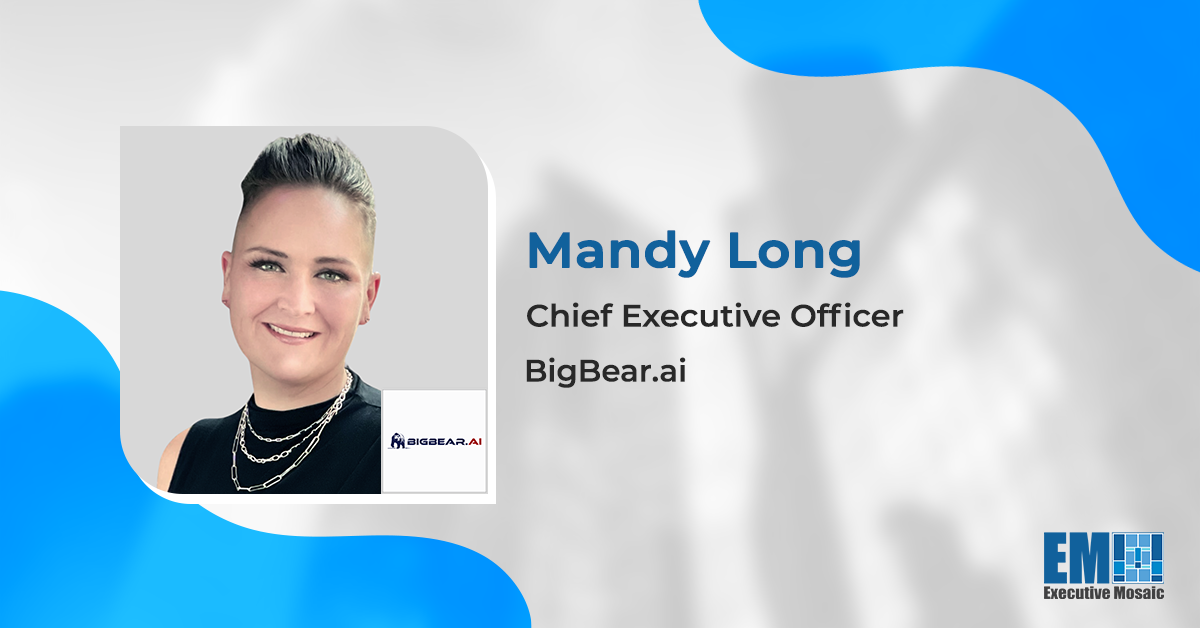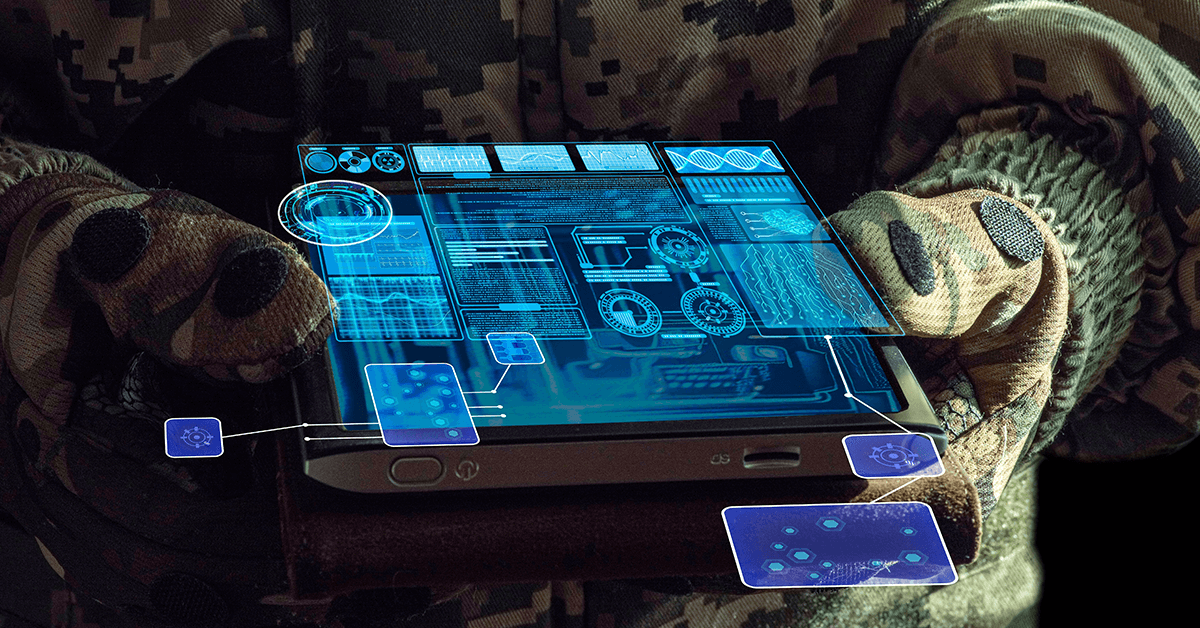Artificial intelligence is currently experiencing a major peak in the commercial world with the skyrocketing popularity of generative AI tools in recent months, which is causing a ripple effect with implications in the public sector too.
Mandy Long, the new CEO of BigBear.ai, delved into the present state of the AI market, where she thinks it could be headed and how the company is harnessing and adapting to the latest tech developments during a conversation with Executive Mosaic.
Learn more about how BigBear.ai is applying AI across its critical missions — read Long’s full Executive Spotlight interview below.
You’ve been at the helm of BigBear.ai for just over six months now. Can you talk about your strategic priorities and your vision for the company under your leadership?
It has been an extraordinary start to my time as CEO of the company. BigBear’s mission is to deliver clarity for the world’s most complex decisions, and our purpose is to create a better world through better choices. I’ve spent a very long time in industries where the decisions really mattered. I spent a long time in healthcare, and I’ve worked in IT for some very complex and high stakes environments. When I looked at BigBear.ai and I saw the opportunity of how much value we could deliver to the communities that we service — whether that’s in national security or healthcare, or manufacturing, the list goes on — it was an easy ‘yes.’
What I’ve seen since then is that we are a company made up of exceptional people that can do things that other people can’t. Many organizations in today’s landscape try to position themselves as the company that can do everything. One of the things I’ve loved about my time here is that we’re the antidote to that. We are a highly specialized organization that knows our superpowers and really lives in them, and a lot of that comes from our people and the work that we do in the markets that we service; we work on the hard stuff.
When I think about BigBear.ai’s long-term vision of a world empowered by decision intelligence, and where we’re going, we’ve been working in the fields of machine learning, artificial intelligence and very complex software for decades, and we get the privilege of being able to apply those in an environment where the work that we do really matters. I think in today’s landscape in particular, that couldn’t matter more than right now.
Tell me about the current state of the artificial intelligence market. Where are you seeing new opportunities in AI, and where do you think the market is heading?
If we think about the step ladder of what the past 15 years have looked like, the first step was that we have all this data. The amount of data growth we see is truly incomprehensible in terms of what happens on a daily basis. That was step one: we’re getting information out, and we’re building these big data landfills.
Then it became about how do we derive insights from that? How do we understand it? How do we unlock it? How do we deal with making it a commodity? How do we move it around and make use of it and apply it to use cases and scenarios?
Then, we have it in these landfills, and we’ve unlocked it to a certain extent, but now, how do we build models? I think that has really been the past five to seven years — it’s been all around the gold rush of AI model development. It manifested in bespoke AI applications, proprietary AI model development and single spoke-based implementations.
For the end user in our community — when we work with the warfighter, or even in the work that we do in the healthcare community or in manufacturing — there’s so much data that we’re starting to hit the point where even the introduction of AI models is overwhelming from a cognitive burden standpoint. So we’re back to the swivel chair concept, it’s just a different swivel chair.
Before, we were looking at huge swaths of reports, now we’re looking at an overwhelming number of applications that can derive insights on data sets. Eventually we’re going to have to be able to solve for that. How do we take the one landfill that was created with the raw data itself to the second landfill that’s been created, which is the massive scale of potential insights of varying degrees of accuracy that are available to a consumer, and how do we actually break through and scale cognition? How do we help people get better at what they do by delivering the insights that actually matter? That’s where I see us going.
For us, we’re really focused on doing that in three areas. We do it in the world of supply chains and logistics — complex manufacturing, distribution, warehouse operations, process optimization — and we have a huge presence in that world. The second area we do it in is cybersecurity, where there’s a lot of reason to do a very good job there because the risk profile for that is increasing on a daily basis in a pretty concerning way. The third is in autonomous systems, and you can see some of the work we’ve been doing there in embedding our AI/ML-based forecasting, situational awareness and Computer Vision (CV) technology on autonomous vessels for the U.S. Navy’s Task Force 59 and our recent teaming agreement with L3Harris.
What we’re trying to apply our skillsets towards for the end users and the customers that we service is not only helping to build and use the right models, but also helping to fundamentally change and evolve the way that they do decision making. This is all aligned with our mission to deliver clarity for the world’s most complex decisions. Because the time scale within which you’re going to have to make really critical decisions is shrinking.
In which applications are you seeing the highest demand for AI/ML from your federal customers, and can you explain what’s driving that demand?
At a macro level, there are a lot of reasons why the technology that we build and provide is very relevant for customers today. Not only do we have some of the macroeconomic realities that are playing out, for example an overwhelmed healthcare system and supply chain disruptions, but from a capital market standpoint, cost of money is very high. So there’s this high degree of compression associated with needing to make decisions with less.
In addition to that, we have a geopolitical global environment that is very disrupted right now. We’ve seen and are continuing to see an increasing amount of risk associated with adversaries, and we are seeing material impact already to the supply chains that provide the resources that our nation relies on.
We’re a software organization, we do technology-led services, so it’s our job to show up in those environments and say, ‘Alright, how do we use our geopolitical and macroeconomic forecasting and simulation engines to be able to start to really look out ahead and plan?’
That applies in the context of life sciences customers that we have, where we’re looking at massive disruptions in the supply chain associated with pharmaceutical manufacturing, or in the case of some of the large manufacturers that exist who are building these vessels, or are building resources that are absolutely critical for our national security. How do we actually get ahead to make sure that we have the pieces that we need to do what we need to do?
On the other side, we’re going through a pendulum shift associated with moving activities that were historically done outside of the United States back in, in some instances because of risk management. It takes a very long time to build new facilities and to get new equipment, and to scale in that way, we have to figure out how to scale with what we have.
A lot of our discrete event simulation tools are being used in those environments to look at how to use these facilities to dramatically increase productivity associated with what we’re actually trying to generate for our customers so we can do that value.
I think the last is probably getting back to just data. We have a very mature data conflation capability that has been used in the field for a while, and what we’re seeing is a high degree of interest, not only in the ability to look forward, but to be able to look and respond to what’s happening right now. So our portfolio is fitting in on both sides. It’s constantly trying to look ahead, but also the reality is that you can’t predict everything. So when something happens, how quickly can we make people aware of it? And then how can we best support them in responding?
Generative AI has been the source of a major AI boom in recent months, but some of these tools are also proving to be risky. How do you think cybersecurity will have to evolve to stay ahead of potential threats posed by AI tools?
You’re very right that there’s a hype cycle playing out that’s associated with generative AI. We are, as a global society, going through the fourth industrial revolution, and the way that people live and work is going to fundamentally change. Generative AI is a component of what is influencing that, but it is not the only influencer.
There’s risk and unbelievable benefit associated with technologies like this. I think our job — not only from a cyber standpoint, because I think that’s just one lens, but at a broader level — is to say how do we think about ethical, appropriate and safe use? I previously spent a very long time in medical devices, where safe and effective was a big part of our DNA for how we built and delivered technology to the world.
The role of ethics is more important than ever, because what we’re sitting on top of now is a set of technical capabilities, raw foundational materials that when pointed at the right problems in the right way are going to be able to save a lot of lives and potentially change the human interaction mechanism for how people gain access to information and how their thoughts and ideas and concepts are scaled. That’s one of the most exciting parts of this is that we are unlocking an ability to augment humanity that we’ve never seen before.
But the flip side of that, which you alluded to, is that those same technologies can be used for incredibly perverse and frankly dangerous behavior associated with misinformation and vulnerable populations. There are a lot of places where we could see it go the other way, and I think the key is going to be to come back to the idea that this technology really gets powerful when it’s done in conjunction with humans.
I am a very strong believer in humans in the loop. Now, I think that dynamic and that relationship will evolve. You have to work up the stack in terms of levels of complexity of decision making. There are going to be places where we get into the world where the machine has begun to master very linear processes, but the human should be empowered to make the determination around when to close the loop. But for the most part, in the world we work in, where we live, these are not simple decisions. It’s all about enabling them through that user experience. I’m a big design proponent and I think that the human factors piece of this is going to be really critical in terms of being able to do it well.
Where are you seeing the most exciting opportunities to deliver better capabilities to our warfighters today, and how are you harnessing these opportunities?
As I shared earlier in terms of the maturity cycle that we’re going through, I think some of the most compelling capabilities that we provide are associated with how to scale highly specialized resources. What I said at the beginning is we’re not a technology company that tries to be everything. We do very specialized things for very specialized communities that work on very hard problems.
Where I see the biggest impact that we’re already having in many ways, but that I think we’ll continue to have is in how we get the right information to the right people at the right time without that being overly burdensome. It sounds really simple when you say it in a single sentence. But think about the number of inputs that these individuals and teams are having to ingest today, just associated with intel correlation, as an example.
That’s where I see BigBear.ai really being able to step in, as a company that’s been at this for decades, is how do we ride alongside, how do we integrate in and become the trusted technical partner who can begin to look in the bowels with the infinite compute that we have access to and help to give the right information so that the people can make the right decisions.






